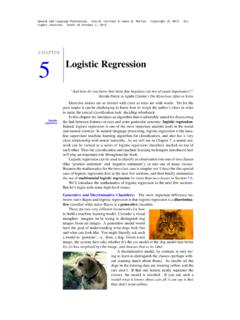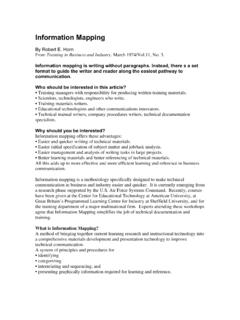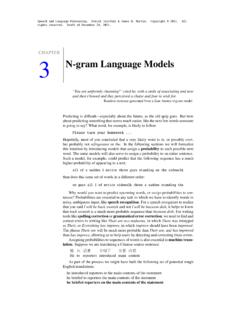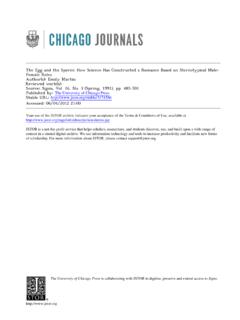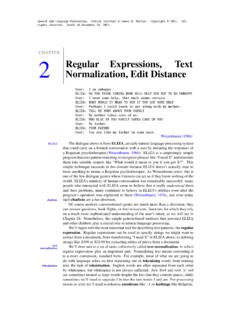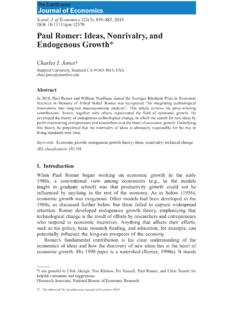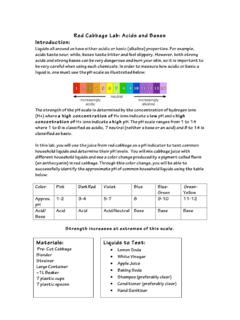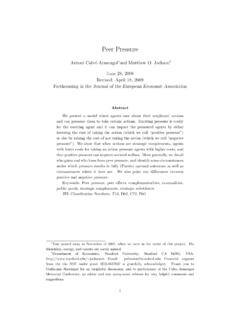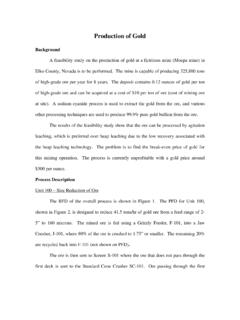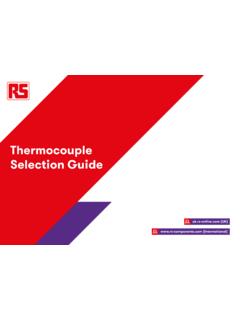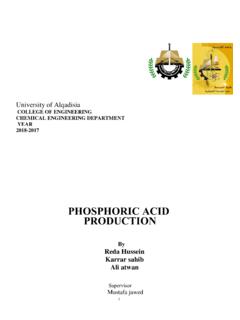Transcription of Economics of Energy - Stanford University
1 Volume: Article: 48 Economics of Energy James L. Sweeney Department of Management Science and Engineering Terman Engineering Center, 323. Stanford University Stanford , CA 94305-4026. Abstract Energy Economics studies Energy resources and Energy commodities and includes: forces motivating firms and consumers to supply, convert, transport, use Energy resources, and to dispose of residuals; market structures and regulatory structures; distributional and environmental consequences; economically efficient use. It recognizes: 1) Energy is neither created nor destroyed but can be converted among forms; 2) Energy comes from the physical environment and ultimately returns there. Humans harness Energy conversion processes to provide Energy services. Energy demand is derived from preferences for Energy services and depends on properties of conversion technologies and costs.
2 Energy commodities are economic substitutes. Energy resources are depletable or renewable and storable or non-storable. Human Energy use is dominantly depletable resources, particularly fossil fuels. Market forces may guide a transition back to renewable resources. Inter-temporal optimal depletable resource extraction paths include an opportunity cost, or rent. World oil prices remain above pre-1973 levels and remain volatile as a result of OPEC market power. Oil supply disruptions of the 1970s led to economic harms. Environmental damages from Energy use include climate change from greenhouse gases, primarily carbon dioxide. Environmental costs not incorporated into Energy prices (externalities) lead to overuse of Energy and motivate policy interventions. 1. 48 Economics of Energy Energy Economics is the field that studies human utilization of Energy resources and Energy commodities and the consequences of that utilization.
3 In physical science terminology, Energy is the capacity for doing work, , lifting, accelerating, or heating material. In economic terminology, Energy includes all Energy commodities and Energy resources, commodities or resources that embody significant amounts of physical Energy and thus offer the ability to perform work. Energy commodities - , gasoline, diesel fuel, natural gas, propane, coal, or electricity can be used to provide Energy services for human activities, such as lighting, space heating, water heating, cooking, motive power, electronic activity. Energy resources - , crude oil, natural gas, coal, biomass, hydro, uranium, wind, sunlight, or geothermal deposits can be harvested to produce Energy commodities. Energy Economics studies forces that lead economic agents firms, individuals, governments to supply Energy resources, to convert those resources into other useful Energy forms, to transport them to the users, to use them, and to dispose of the residuals.
4 It studies roles of alternative market and regulatory structures on these activities, economic distributional impacts, and environmental consequences. It studies economically efficient provision and use of Energy commodities and resources and factors that lead away from economic efficiency. Properties of Energy Resources and Energy Commodities 2. Other than all embodying significant amounts of physical Energy , Energy resources or commodities vary greatly. They may embody chemical Energy ( , oil, natural gas, coal, biomass), mechanical Energy ( , wind, falling water), thermal Energy (geothermal deposits), radiation (sunlight, infrared radiation), electrical Energy (electricity), or the potential to create Energy through nuclear reactions (uranium, plutonium.) They have differing physical forms.
5 Crude oil, most refined petroleum products, and water are liquids. Of water includes available Energy only through its motion. Coal, most biomass, and uranium are solids. Natural gas and wind are in gases, with wind including available Energy based only on its movement. Geothermal Energy is available through hot liquids (normally water) or solids (subterranean rock formations). Solar radiation is a pure form of Energy . Electricity consists of electrons moving under an electrical potential. Resources can be viewed as renewable or depletable. Some renewable resources can be stored; others are not storable. These issues will be discussed more fully in a subsequent section. Table 1 summarizes the Energy form, physical form, renewable/depletable distinction for several common Energy resources and commodities.
6 1. Energy Conversion Processes 3. A fundamental property of Energy is expressed by the first law of thermodynamics: Energy can be neither created nor destroyed (except through nuclear reactions transforming matter to Energy .) Energy can be converted between forms and human use of Energy typically involves such conversions for human ends. Energy conversion processes are basic to human experience. Fire, providing heat and light, is a process by which chemical Energy stored in the fuel, say, wood, is converted to thermal Energy and radiant Energy . Chemical Energy stored in wood is the result of photosynthesis, whereby plants convert Energy in sunlight to chemical Energy , stored in the plant material. Carbohydrates in food are converted within the human body to thermal Energy and mechanical Energy , providing body warmth and movement.
7 The industrial revolution was characterized by a change from use of hand tools, using human mechanical Energy , to machine and power tools. Machine tools allowed conversion of Energy in falling water to mechanical Energy (water wheels) or conversion of chemical Energy in wood or coal to mechanical Energy (steam engines) for industrial processes. Humans now routinely harness complex sequences of Energy conversion processes to provide desired services. Crude oil is separated into refined products such as gasoline, diesel oil, jet fuel, heavy distillates, that embody chemical Energy . Gasoline or diesel oil are explosively 4. burned in internal combustion engines, converting chemical Energy into thermal Energy . Heated gases push engine pistons, converting thermal Energy into mechanical Energy .
8 Some is lost as heated gases or as radiant Energy . The mechanical Energy moves the automobile and, in the process, is converted to thermal Energy through friction within the automobile or between the automobile and the road or air. Some mechanical Energy is converted to electrical Energy by a generator in the automobile, to power electrical equipment. Some electrical Energy is converted into chemical Energy in the automobile battery. To start the car, chemical Energy in the battery is converted to electrical Energy , that is then converted to mechanical Energy to turn the engine. Similarly, coal combustion converts chemical Energy into thermal Energy to create steam, which powers a turbine in an electric generating plant, converting the thermal Energy into mechanical Energy and then into electrical Energy .
9 Electricity can power a motor (converting to mechanical Energy ), heat a room (to thermal Energy ), or light a bulb (to thermal Energy , then to light). This Energy is later converted to thermal Energy , which ultimately is radiated into space. Energy Economics recognizes the fundamental physical realities that 1) no Energy is created or destroyed but that Energy can be converted among its various forms, and 2) Energy comes from the physical environment and ultimately is released back into the physical environment. Thus, Energy Economics is the study of human activities using Energy resources from naturally 5. available forms, through often complex conversion processes, to forms providing Energy services. Several issues of the demand for Energy will be examined next. 2. Demand for Energy as a Derived Demand Demand for Energy is derived from wishes to use Energy to obtain desired services.
10 It is not derived from preferences for the Energy commodity itself. Energy demand depends primarily on demand for desired services, availability and properties of Energy conversion technologies, and costs of Energy and technologies used for conversion. For example, consumers use gasoline to fuel an automobile or other motorized vehicle, converting gasoline to mechanical Energy for motive power. The amount of gasoline used is proportional to the miles the auto is driven and inversely proportionate to the efficiency by which gasoline is converted to useful mechanical Energy , measured as miles per gallon (Mpg). of gasoline of the automobile. Demand for gasoline is thus derived from choices about distances vehicles are driven and their Energy conversion efficiencies. Similarly, electricity is purchased by consumers only to perform functions using electricity.
